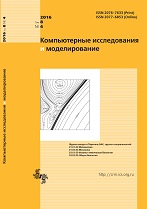|
This article is cited in 1 scientific paper (total in 1 paper)
MODELS IN PHYSICS AND TECHNOLOGY
The development of fracture mathematical models for numerical solution of exploration seismology problems with use of grid-characteristic method
M. V. Muratova, I. B. Petrova, V. B. Levyantb
a Moscow Institute of Physics and Technology, Computer Science and Computational Mathematics Department,
9 Institutskii per., Dogolrudnyi, 141701, Russia
b CGE PLC,
38/3 Narodnogo Opolcheniya st., Moscow, 123298, Russia
Abstract:
The article contains the description of developed mathematical models of fractures which can be used for numerical solution of exploration seismology problems with use of grid-characteristic method on unstructured triangular and tetrahedral meshes. The base of developed models is the concept of infinitely thin fracture. This fracture is represented by contact boundary. Such approach significantly reduces the consumption of computer resources by the absence of the mesh definition inside of fracture necessity. By the other side it lets state the fracture discretely in integration domain, therefore one can observe qualitative new effects which are not available to observe by use of effective models of fractures, actively used in computational seismic.
The main target in the development of models have been getting the most accurate result. Developed models that can receive the response close to the actual response of the existing fracture in geological environment. We considered fluid-filled fractures, glued and partially glued fractures, and also fractures with dynamical friction force. Fracture behavior determinated by the nature of condition on the border.
Empty fracture was represented as free boundary condition. This condition give us opportunity for total reflection of wave fronts from fracture. Fluid-filling provided the condition for sliding on the border. Under this condition, there was a passage of longitudinal and total reflection of converted waves. For the real fractures, which has unequal distance between the borders has been proposed the model of partially glued fracture. At different points of the fracture's boundary were sat different conditions. Almost the same effect is achieved by using a fracture model of dynamic friction condition. But its disadvantage is the inabillity to specify the proportion of fracture's glued area due to the friction factor can take values from zero to infinity. The model of partially glued fracture is devoid of this disadvantage.
Keywords:
numerical modeling, grid-characteristic method, unstructured triangular meshes, unstructured tetrahedral meshes, exploration seismology, fractured media, mathematical fracture model.
Received: 17.10.2016
Revised: 12.11.2016
Accepted: 24.11.2016
Citation:
M. V. Muratov, I. B. Petrov, V. B. Levyant, “The development of fracture mathematical models for numerical solution of exploration seismology problems with use of grid-characteristic method”, Computer Research and Modeling, 8:6 (2016), 911–925
Linking options:
https://www.mathnet.ru/eng/crm36 https://www.mathnet.ru/eng/crm/v8/i6/p911
|

| Statistics & downloads: |
| Abstract page: | 393 | | Full-text PDF : | 166 | | References: | 56 |
|




 Contact us:
Contact us: Terms of Use
Terms of Use
 Registration to the website
Registration to the website Logotypes
Logotypes









 Citation in format
Citation in format 
